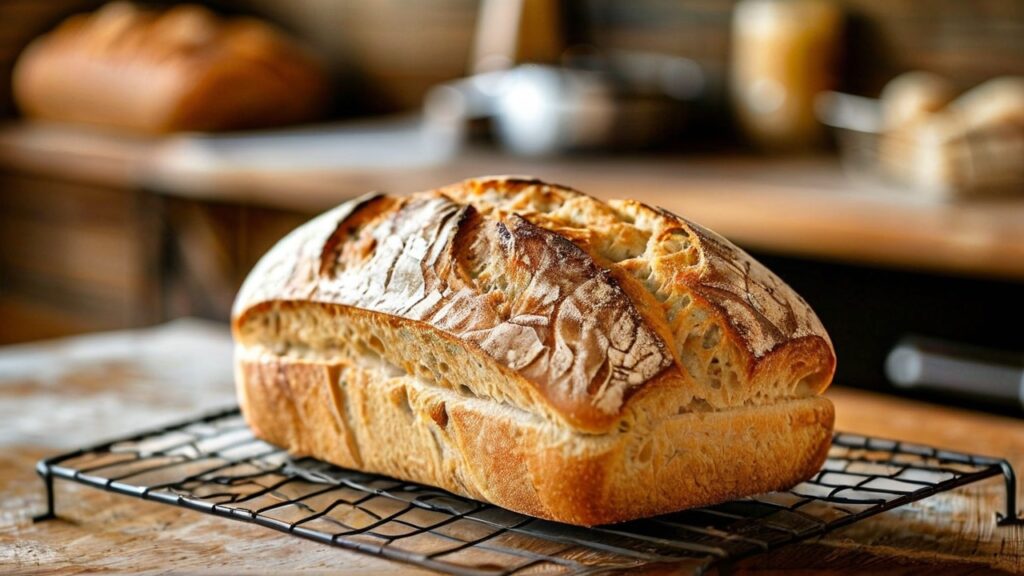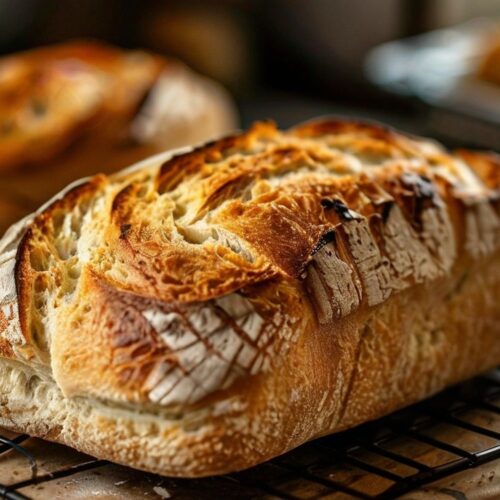Sourdough Sandwich Bread Recipe

Sourdough Sandwich Bread Recipe
Table of Contents
Sourdough Sandwich Bread Recipe
Discover the perfect sourdough sandwich bread recipe that combines a tangy flavor with a soft, airy texture. This recipe is ideal for making delicious sandwiches, toast, or simply enjoying with butter. With just a few simple ingredients and some patience, you can bake your own sourdough sandwich bread at home, bringing a delightful artisan touch to your meals.
Description
Sourdough bread is beloved for its unique flavor, chewy texture, and impressive health benefits. This sourdough sandwich bread recipe offers a straightforward approach to crafting a loaf that’s perfect for sandwiches or toast. Unlike commercial bread, this homemade version contains no preservatives, allowing you to enjoy a wholesome and flavorful loaf that can be customized to your liking.
What Makes This Sourdough Sandwich Bread Recipe Special?
The magic of sourdough lies in its fermentation process. Wild yeast and lactic acid bacteria work together to create a tangy flavor profile and improve the bread’s texture. This recipe utilizes an active sourdough starter, so make sure yours is bubbly and ready to go.

Benefits of Sourdough Bread:
- Digestibility: The fermentation process breaks down gluten, making sourdough easier on the stomach.
- Flavor: The natural fermentation adds a complex taste that enhances any sandwich.
- Preservation: The acidity in sourdough acts as a natural preservative, keeping the bread fresh longer.
Tips for Success
- Starter Activity: Ensure your sourdough starter is well fed and active. A bubbly starter is essential for a good rise.
- Hydration: This recipe has a higher hydration level, resulting in a softer crumb. Adjust the water as needed based on your flour type.
- Shaping: Proper shaping techniques help develop the gluten structure, leading to a better rise and texture.
Storage
Once baked, let your sourdough sandwich bread cool completely before slicing. Store it at room temperature in a paper bag or wrapped in a clean kitchen towel to keep the crust crisp. For longer storage, slice the bread and freeze it in an airtight container. This allows you to enjoy fresh slices anytime!
Ingredients
- 1 cup active sourdough starter (about 240g)
- 1 ½ cups warm water (about 110°F/43°C)
- 4 cups all purpose flour (about 480g)
- 2 teaspoons salt
- 1 tablespoon honey or sugar (optional)
- 1 tablespoon olive oil (optional)

Instructions
- Mix the Dough: In a large bowl, combine the active sourdough starter and warm water. Mix well.
- Gradually add the flour and salt, mixing until a rough dough forms.
- Autolyse: Let the dough rest for 30 minutes to 1 hour. This allows the flour to hydrate and the gluten to develop.
- Kneading: Knead the dough for about 10 minutes until it becomes smooth and elastic. You can also use the stretch and fold technique.
- First Rise: Place the dough in a lightly greased bowl, cover with a damp cloth, and let it rise at room temperature for about 4-6 hours, or until doubled in size.
- Shape the Dough: Gently deflate the dough and transfer it to a floured surface. Shape it into a loaf by folding in the sides and rolling from the bottom.
- Second Rise: Place the shaped dough in a greased 9×5-inch loaf pan. Cover and let it rise for another 2-3 hours, or until puffy.
- Preheat Oven: Preheat your oven to 450°F (230°C).
- Bake: Once the dough has risen, bake it in the preheated oven for 40-50 minutes, or until golden brown and hollow-sounding when tapped.
- Cool: Remove the bread from the oven and let it cool in the pan for 10 minutes before transferring to a wire rack. Allow it to cool completely before slicing.

Sourdough Sandwich Bread Recipe
Ingredients
- 1 cup active sourdough starter about 240g
- 1 ½ cups warm water about 110°F/43°C
- 4 cups all-purpose flour about 480g
- 2 teaspoons salt
- 1 tablespoon honey or sugar optional
- 1 tablespoon olive oil optional
Instructions
- Mix the Dough: In a large bowl, combine the active sourdough starter and warm water. Mix well.
- Gradually add the flour and salt, mixing until a rough dough forms.
- Autolyse: Let the dough rest for 30 minutes to 1 hour. This allows the flour to hydrate and the gluten to develop.
- Kneading: Knead the dough for about 10 minutes until it becomes smooth and elastic. You can also use the stretch and fold technique.
- First Rise: Place the dough in a lightly greased bowl, cover with a damp cloth, and let it rise at room temperature for about 4-6 hours, or until doubled in size.
- Shape the Dough: Gently deflate the dough and transfer it to a floured surface. Shape it into a loaf by folding in the sides and rolling from the bottom.
- Second Rise: Place the shaped dough in a greased 9×5-inch loaf pan. Cover and let it rise for another 2-3 hours, or until puffy.
- Preheat Oven: Preheat your oven to 450°F (230°C).
- Bake: Once the dough has risen, bake it in the preheated oven for 40-50 minutes, or until golden brown and hollow-sounding when tapped.
- Cool: Remove the bread from the oven and let it cool in the pan for 10 minutes before transferring to a wire rack. Allow it to cool completely before slicing.
Notes
- Sourdough Starter: If you don’t have a starter, you can create one by mixing equal parts flour and water and letting it sit at room temperature for 5-7 days.
- Flour Substitutions: Feel free to experiment with whole wheat or spelt flour for a different flavor and nutrition profile.
- Add-ins: Consider adding seeds, herbs, or cheese for additional flavor.






